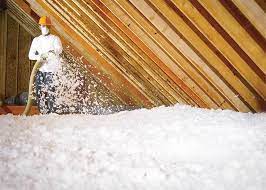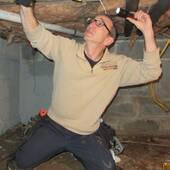Home inspectors in New Jersey are required to evaluate and inspect insulation in the attic. We are not required to describe the insulation or determine its depth however this is a and added benefit to our New Jersey home inspection clients if we could determine if the insulation is sufficient enough. Other home inspection organizations require that the depth of the insulation be reported on. Most of the heat loss in an attic space is through the attic. Increasing attic insulation is a cost-effective and relatively easy way for homeowners to improve energy efficiency in their home.
Many older homes have very little, or no insulation installed. Blown in or loose fill insulation can be installed on the floor of the attic space to improve energy efficiency in an attic that is vented. When installing blown in or loose fill insulation, care is needed to make sure that all of the ceiling joist bays are completely filled leaving no openings or gaps around wiring or pipe penetrations. Loose fill insulation should be installed that it covers the tops of the joists to prevent a condition called thermal bridging. Thermal bridging is also referred to as cold bridging. These are weak points in the building envelope which allow heat to pass through easily. They occur where materials which are better conductors of heat are allowed to form a bridge between the inner and outer face of a structure. This typically happens where there is a gap in the insulation layer or where there is an element such as a floor joist penetrates through the insulation. The insulation should be installed evenly throughout the attic space so there are no low areas or high areas. The blown in insulation should appear flat.
The attic floor often referred to as the ceiling plane should be thoroughly air sealed before the insulation is installed. Improvements to the air control is important to have high performance and energy efficiency. Any older and existing insulation should be removed to provide access to the attic floor for proper sealing. Any dust or debris should also be removed so the sealants will have proper adhesion. All cracks, seams and openings should be sealed completely with spray foam insulation and appropriate caulking material.
All hole's gaps and openings should be properly sealed. Solid blocking should be used at any larger holes in the attic floor. Metal blocking and collars can be made and constructed around hot flues to keep the insulation from touching the hot metal. Covers can be bought or constructed to cover recessed lights that are not insulated.
The existence of flooring installed on the ceiling joist will make it challenging to air seal the attic flooring. If the air control is to be established on the attic floor than any attic flooring installed above must be removed to provide access to this attic floor surface. Sometimes this proves challenging. Another alternative method is to install insulation on top of the existing attic floor. To do this option sufficient insulation is required to control condensation and a very efficient air control connection must be made from the top of the exterior walls to the perimeter of the attic floor.
One benefit of a vented rather than un-vented attic is that moisture originating from the interior of the house will be vented to the exterior of the house before causing damage to the roof sheathing. Another significant advantage of having a vented attic in a cold weather climate is that they aid in reducing and significantly lowering the probability of ice dams forming at the areas of the home. Ice dams as we know form when heat leaks from the interior of the house through holes in the attic flooring. Insufficient insulation or heat loss from the duct work or high-hat lights melts the snow on the roof. This melted snow in the form of water travels down to the edges of the roof where it rephrases creating ice dams. Attic ventilation helps to vent this heat and to help prevent ice dam formation.
New Jersey home inspectors should understand the basic method for installing blown in and loose fill insulation on the attic floor.
Step one: Before any insulation work is performed the area should be professionally inspected for any knob and tube wiring and bathroom fans that vent into the attic space. These conditions should be professionally rectified before installing the loose fill insulation. Also, any asbestos containing materials such as vermiculite should be properly inspected for and removed prior to installation.
Step two: Any insulation that is pre-existing should be removed and the attic flooring area should be cleaned to allow for proper application and adhesion of caulking and spray foam sealants.
Step three: All penetrations and openings should be properly sealed. The top plate to drywall seams and the top plate to baffle seams should also be sealed. Solid blocking should be installed around large holes. Metal collars should be installed around hot pipe penetrations such as flue pipes. Covers should be installed over any non-IC rated high hat light fixture cans.
Step four: Proper attic ventilation should be confirmed. All ventilation in the attic should be open unobstructed and fully operational. Baffle should be installed to allow for the soffit vents to operate properly.
Step five: Install loose fill insulation or blown in insulation. The height of the insulation should meet or exceed the current requirements. The entire attic floor should be covered in a smooth and even manner without low spots. You should aim to deliver insulation at a thickness of about 13 inches or more to provide the necessary R-valve for a Northeast home.
A NJ Home inspector should be required to evaluate the type of insulation present in the attic and determine the approximate height or depth of the material in order to determine if the amount of insulation is sufficient to help control energy loss. Home inspectors should educate clients about how installing additional insulation is a cost effective and relativity easy way to improve a home's energy efficiency. A NJ home inspectors should be able to identify a good attic insulation installation and should be able to report on the adequacy of the existing attic ventilation system.


Comments(4)